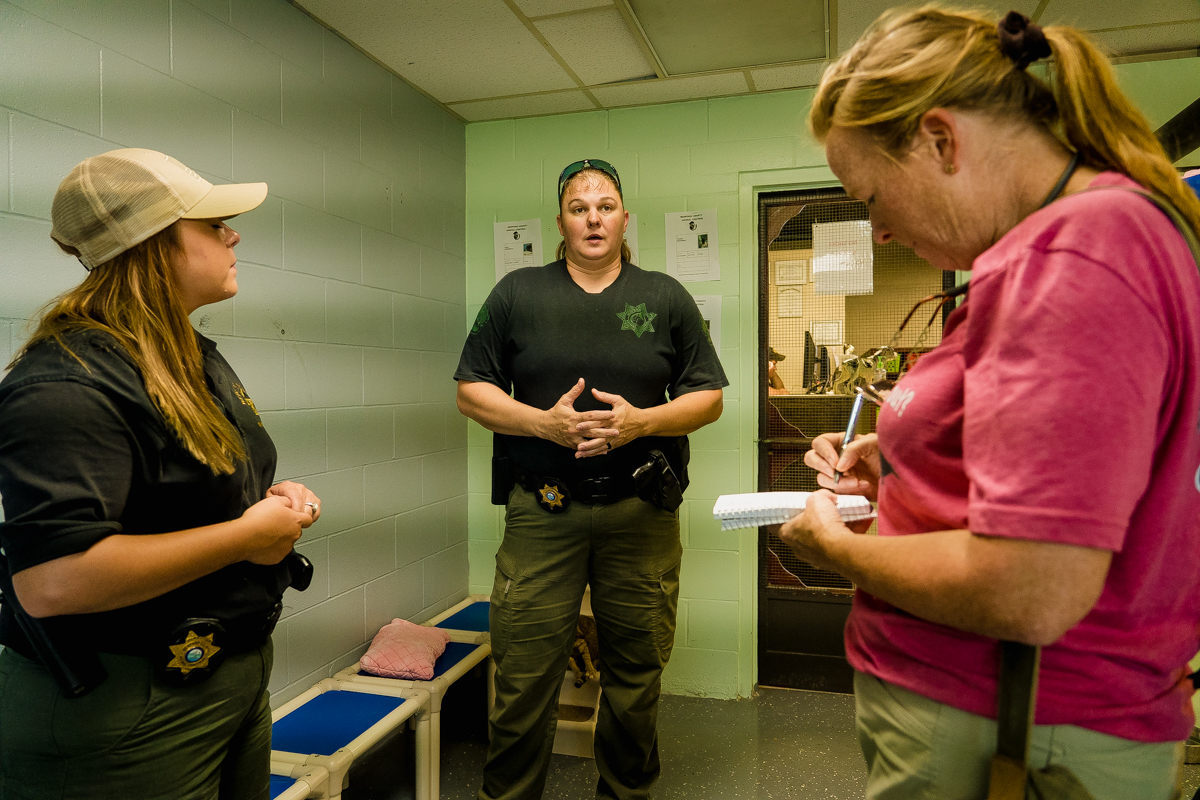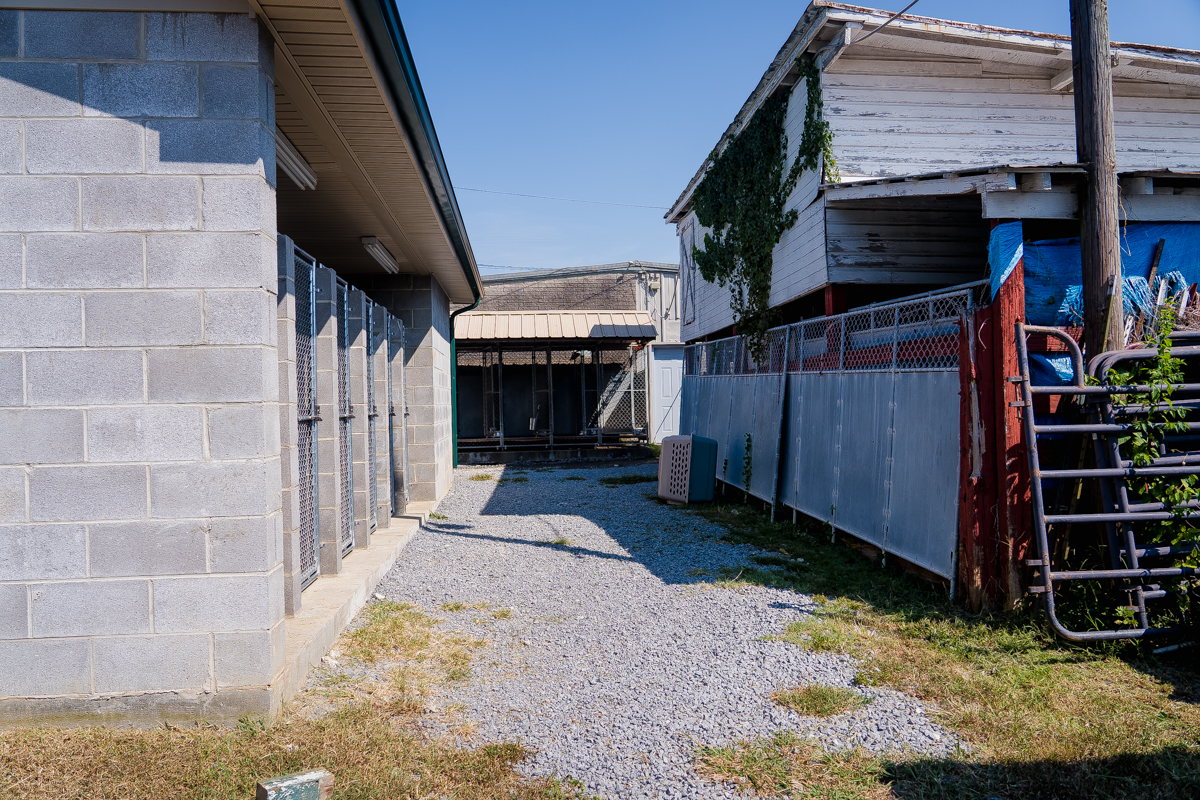We left Shelbyville Animal Control at 10:20am, and at 10:28 we were navigating the tight, tiny parking lot of Bedford County Animal Control.
These shelters have more in common than I expected. Considering they serve the same basic public, I imagined they were vastly different, hence the need for two shelters two miles apart.
Bedford’s intake is slightly bigger and so is their building. Their recently redesigned lobby is cavernous and a brightly painted free-roaming cat room with a clever homemade cat tree can be seen through large picture windows.
We met Maria Hughes, the director, a college-educated Animal Control officer who is young, soft-spoken, and the first shelter director I’ve met who has great nails. She’s been on the job less than a year; previously she was the deputy director and fell into the role of director when the previous director left suddenly, giving her one day of training before he departed. Her pretty eyes grew wide as she explained this; she still seemed surprised to find herself in this role.
Maria is excited about her new position and dreams of a bigger, better building with more room to house animals, including livestock. Her goals at this point are to maintain a qualified staff, make changes to the shelter so it is ADA compliant, improve the volunteer program, and update the existing kennels. Bedford currently does not euthanize animals for reasons other than aggression and medical and thanks to TNR (trap-neuter-release) programs no longer kills cats either.
She introduced us to the rest of the staff who all have some kind of background in animal welfare or animal husbandry. There are three full time and three part-time employees to handle the approximately 1200 animals that pass through their door. When I asked if that number was going up or down yearly, she and Josie, the deputy director, another experienced ACO who accompanied us on our tour, agreed that this year they are seeing a big spike in owner surrenders.

Like Shelbyville, though, Bedford is not open-intake—they will not take an owner surrender unless it is clearly adoptable. Josie recounted the story of several huge hoarding cases they’ve dealt within the last few years. A natural storyteller and an animal control officer who is clearly good at her job, I appreciated her perspective.
About a quarter of Bedford’s animals are adopted out locally, the rest go to rescues. For a tiny shelter, Bedford surprisingly has their own tiny veterinary suite with two surgical tables and a recovery area. A local vet does spay and neuter surgeries and for a day the ACO’s magically transform into veterinary assistants. On one day recently they performed 59 surgeries—a record for the Bedford and the vet.
We walked through the kennels and met a few of the dogs, including a mama who had just given birth the night before and a very pregnant black lab mama who they are hoping to get out through rescue before she delivers.
We followed Maria and Josie outside into the heat to see the newest kennels built a year ago by the previous director. I was surprised to see that they resembled the old-fashioned pound design—cinderblock walls with tiny outdoor runs attached, no air-conditioning, just fans.
Inside, the dogs faced each other over a narrow cement lane, so reminiscent of the pounds I recently visited in western Tennessee.
Bedford is landlocked but has a relatively large ‘backyard’ a large part of which is consumed by a big, wooden barn that holds old cages and supplies. In addition to the ‘new’ cement kennel building, there are a few large outdoor kennels with igloo dog houses where a small litter of puppies was housed.
Closer to the building, there is a row of kennels with a wire mesh floor where the dogs were placed to be fed while their kennels are being cleaned and to give them some outside air. I’d never seen kennels like those—off the ground with wire floors like giant rabbit hutches. Maria told me that the big coonhounds tend to get their pads stuck in the wire floors and they have to use dawn dish soap to free them.

The ‘new’ kennels are on the left, the holding kennels for cleaning are straight ahead, and the run-down barn currently used for storage is on the right.
Surveying the area behind the shelter cluttered with useless or dysfunctional spaces, I immediately thought of Rescue Rebuild and how they could likely transform this space.
That is one short-term solution. But there needs to be a long-game plan not just for Bedford, but for the entire area. It seems crazy that there are four competing shelters within a few miles of each other. Beyond Shelbyville Animal Control and Bedford Animal Control, there is a Humane Society and a private rescue, New Destiny. All of these people are working hard to save the endless stream of unwanted animals in Bedford County.
I am not naive enough to believe that there aren’t conflicting agendas, practices, and personalities that might make combining their efforts impossible, but from a common sense and for-the-animals-sake standpoint it seems much smarter to pool your resources and consolidate your efforts in one shelter where all that passion and talent can do the most good.
Creating one shelter, a new progressive facility with modern design and practices to meet the needs of animals and the public would change the game in Bedford County. Each of these organizations has rescue contacts, resources, ideas, energy, and volunteers. Think of the powerhouse they would be if their efforts were combined!
But this is a small town, and if it’s anything like the small town where I come from, change happens slowly and personal histories run deep.
Still, a girl can dream.
I am inspired by this little nest of committed animal advocates. I’m not sure I know of another area with so many shelters concentrated so close together. They prove my point that people do care. The people who know about the problem step in to help.
But more people need to know. Please help us tell them. Share this blog, and follow our Facebook and Instagram, tagging, reposting, and commenting. It is time to bring change to the situation for far too many animals who have no voice. We must be their voice.
Blessings,
Cara





Michelle Ferrara
I am loving following along during your trip south this time!!!! You continue to highlight the good that is being done by so many to try to turn the tide in rescue!!!! I hope that when you get home, you take some time to delve deeper into our local SPCA and highlight some of the work that is being done there! There is a terrific TNR (trap-neuter-RETURN) program for cats that doesn’t get enough attention locally! It is one thing that they are doing right!!!!! But it is also a very high-kill shelter! It would be nice to see some local rescues pulling animals from our SPCA to reduce the number of senseless euthanasias that are performed daily!!!!
Cara Sue Achterberg
you read my mind! Already have an email into our SPCA to try to get an interview/tour and find out how I can help! Thanks for following and all your support!